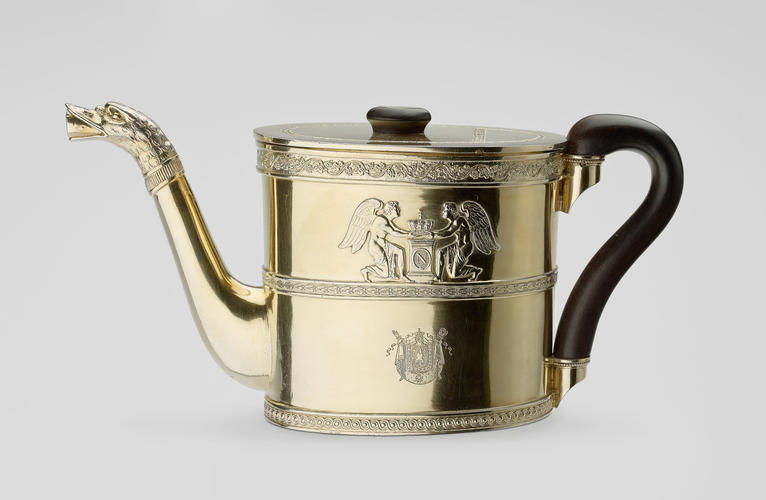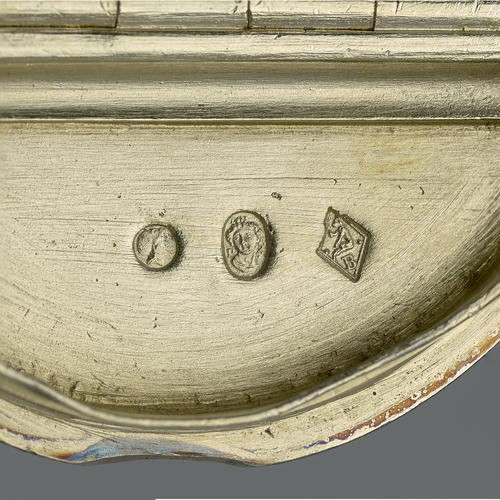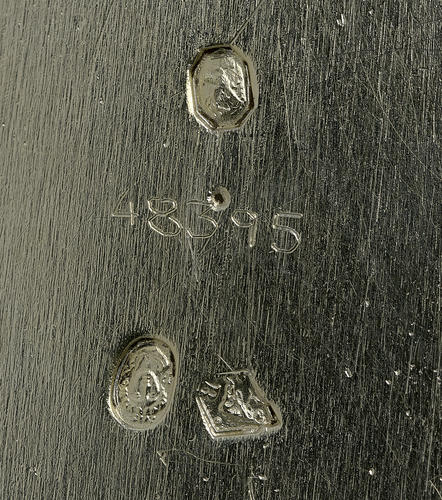Teapot 1809-15
Silver gilt, ebony | Measurements 9.3 x 18.4 x 6.2 cm. Weight 432 g (whole object) | RCIN 48395
-
Oval straight-sided teapot with a flat lid, both hinged and pull-off, with flattened oval ebony knop and engraved border of wrigglework. Teapot with cast fruiting vine border, ebonised wooden handle, spout with swan's head, girdle of berried laurel, lower guilloche border. Applied on both sides with winged kneeling genii holding a crown above a rectangular tablet with N monogram and engraved on one side with Napoleon's imperial coat of arms with sceptres, crown, cloak and Order.
This teapot, along with a tea caddy also in the Royal Collection (RCIN 48396), were undoubtedly pieces from one of Biennais's necessaires de voyages, the caddy designed to fit inside the pot when the pieces were packed into the case.
Teapot struck on hinged part of lid and base with fineness mark, mark of the Association des Orfevres, and maker's mark of Biennais; struck on outer part of lid with mark of the Association des Orfevres, guarantee mark and maker's mark of Biennais; teapot engraved on one side, Napoleon; tea caddy unmarked; both pieces engraved with coat of arms of Napoleon, with badge of the Legion d'Honneur; both pieces stamped with N cipher.Provenance
Made for Napoleon I; acquired by King Edward VII when Prince of Wales.
Martin Guillaume Biennais (1764–1843) was originally a cabinet maker and tabletier (dealer and maker of small objects) with established premises at 283 rue St Honoré by 1789 'Au Singe violet' (at the sign of the purple monkey). With the ending of guild restrictions following the passing of the Chapelier laws in 1791 he diversified his business to include the production of silver and gilt items. He supplied Napoleon Bonaparte and his family from as early as 1798 including, in 1804, the Emperor's crown and sceptre for his coronations in Paris and Milan.
Edward VII was a great admirer of Napoleon, creating a Napoleonic Room at Marlborough House which was lined in silk woven with Imperial motifs and filled with Empire furniture. The room contained numerous busts, sculptures, prints and paintings of the Emperor. However there was little that belonged first hand to Napoleon himself and the teapot and caddy were listed with careful annotation of their provenance in the 1885 inventory of Marlborough House as the Emperor's personal property. It was Queen Mary who rationalised the Napoleonic items in the Royal Collection, displaying some of these works with items at Windsor Castle collected by George IV. -
Creator(s)
(nationality)Acquirer(s)
-
Medium and techniques
Silver gilt, ebony
Measurements
Measurements 9.3 x 18.4 x 6.2 cm. Weight 432 g (whole object)
432 g (Weight) (whole object)
Place of Production
Paris [Île-de-France]












